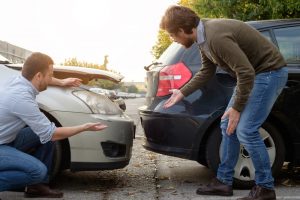Posted on Thursday, February 10th, 2022 at 10:36 am
If you were involved in a car accident that was caused by someone else’s negligence, you may be entitled to compensation. To achieve your goal, you and your personal injury attorney must prove that the other driver was at fault.
“Fault” refers to who is responsible for the accident. After an accident, the police may find that one, two, or three people are responsible for the accident. How the fault is shared among the drivers affects how compensation is determined.
The law team at Jonathan R. Brockman, P.C. is here to answer your questions. Contact us today and we can get started on your case.
Is Georgia an At-Fault State?
 There are very few states in the U.S. that are no-fault states. Georgia is an at-fault state. This means after a car accident, law enforcement that responds to the accident will assign fault to one or more drivers.
There are very few states in the U.S. that are no-fault states. Georgia is an at-fault state. This means after a car accident, law enforcement that responds to the accident will assign fault to one or more drivers.
Georgia laws allow fault to be assigned and apportioned separately to each of the drivers involved. This is called proportional comparative fault. This is important when compensation is negotiated with the insurance company or determined by the court.
Under Georgia law, the injured party can recover compensation for damages or injuries if the other driver carried more than 50 percent of the fault in the accident. This means, to determine whether you can seek recovery for damages, it must be determined that you are at least less than 50 percent at fault for the accident.
Why This Matters
After every accident, blame is assigned to one or both drivers. In Georgia, the injured party can pursue compensation through their own insurance company, the at-fault driver’s insurance company, or through a personal injury civil lawsuit.
Georgia also uses proportional comparative fault. This means that a percentage of the fault is assigned to each driver in the accident. In some cases, one driver can hold 100 percent of the responsibility.
Sometimes, the proportion of fault after an accident can be very clear. However, in others, it is more difficult to determine. Your personal injury attorney will gather evidence to support your claim and help the court and insurance companies find in your favor. When the police attend the accident scene, they help decide who was at fault.
But this information does not always clear things up. In some cases, more than one citation could be issued and in others, the police may never have been called to the scene. When fault is in question, insurance companies will deploy their own investigators. It is important to note that they wish to protect their own interests. This means they could attempt to deflect the fault away from their insured.
If you have questions that need immediate answers, our experienced team is here to help you. Contact us today.
How Shared Fault is Measured
Compensation for damages is based on the percentage of fault the driver bears for causing the accident. For example, if a speeding driver goes through a green light but is hit by another driver who runs a red light, the court may decide the speeding driver bears 20 percent of the fault of the accident and the driver who ran the red light bears 80 percent of the fault.
In this case, the speeding driver can receive a settlement to cover their medical costs and lost wages, but it will be reduced by 20 percent since the driver held 20 percent of the responsibility for the accident. Fault can be measured by accounting for specific factors that contributed to the car accident. For example, contributing factors can include driving under the influence, distracted driving, tailgating, running a red light, speeding, and road rage.
 One of the most important pieces of evidence you have after the accident is the police officer’s accident report. This report contains important information regarding the scene of the accident and what happened immediately beforehand. The court sees this version of events as more credible than other witness statements that your personal injury attorney may find in the following days and weeks after the accident.
One of the most important pieces of evidence you have after the accident is the police officer’s accident report. This report contains important information regarding the scene of the accident and what happened immediately beforehand. The court sees this version of events as more credible than other witness statements that your personal injury attorney may find in the following days and weeks after the accident.
If possible, it’s helpful to have pictures of the accident. However, if your injuries required an ambulance trip to the hospital, you may have been unable to take pictures. Your injury attorney will contact the witnesses at the scene, if the officer listed any in the police report, to determine whether they took pictures. They will also speak with the witnesses to find out what happened immediately before the accident and during the accident. This can help determine fault.
Each of these factors is used to measure the percentage of fault each driver carries for the car accident. Unfortunately, it’s not always clear who was at fault for the accident. By providing evidence gathered at the scene, you can influence the final determination and make sure the process runs smoothly.
Contact Jonathan R. Brockman, P.C. for Help Getting Fair Compensation
If you were involved in a car accident that was not your fault, it’s important to seek the help of an experienced Georgia car accident lawyer as soon as possible. The at-fault party’s insurance company is represented by experienced counsel and you should be, too.
You have nothing to lose and everything to gain by hiring Jonathan R. Brockman, P.C. to represent you and protect your rights. Our experienced legal team doesn’t charge any fees until we have collected compensation for you through negotiations with the insurance company or after skillfully arguing your case in court.
Call our office today at 770-205-8887, or reach out to us online to schedule your free consultation.
